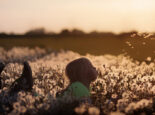John Clare – Peterborough’s Rural Muse

Despite city status and an abiding industrial heritage, Peterborough is a place with deep rural roots. The surrounding countryside and villages are as diverse as they are beautiful – think rolling meadows straight out of Tolkein’s Shire on one side, the brooding, mystical Fens on the other – and much remains as it was decades, even centuries before. It was this landscape that the poet John Clare (1793–1864) captured and treasured in his writing, leaving a legacy of insight and inspiration that continues to this day...
The life and times of John Clare
“How sweet I’ve wandered bosom-deep in grain,
When Summer’s mellowing pencil sweeps his shade
Of ripening tinges o’er the chequer’d plain:
Light tawny oat-lands with a yellow blade;
And bearded corn, like armies on parade.”
(Extract from Summer Tints by John Clare)
John Clare was never meant to be a poet – or any kind of artist, for that matter.
 Born into rural poverty and an illiterate family in 1793, Clare would only have been expected – from childhood until death – to provide unremarkable, back-breaking labour for very little pay (something he did do at times to make ends meet). Art created by working people (then as now) was as rich, varied and beautiful as anything found in the opera houses and galleries of urban taste- makers, but labouring men and women were not expected to earn a living by their art, and rigid class divides would make it difficult for them to find wealthy, sympathetic patrons.
Born into rural poverty and an illiterate family in 1793, Clare would only have been expected – from childhood until death – to provide unremarkable, back-breaking labour for very little pay (something he did do at times to make ends meet). Art created by working people (then as now) was as rich, varied and beautiful as anything found in the opera houses and galleries of urban taste- makers, but labouring men and women were not expected to earn a living by their art, and rigid class divides would make it difficult for them to find wealthy, sympathetic patrons.
Clare’s first piece of luck was going to school and learning to read and write, something he did until he was 12 (although he also worked in the fields). Despite his reliance on manual labour for a fluctuating income, Clare continued to read, to write and to practise his craft, resulting in his first book of poetry, Poems Descriptive of Rural Life and Scenery, getting published (by John Keats’ publisher – Clare’s second piece of significant luck).
Although inspired in terms of style and approach by writers such as James Thompson and Robert Burns, Clare’s muse was always his beloved Peterborough countryside (then designated as Northamptonshire). Vivid, bursting with emotion and imagery, one only has to read a few lines of Clare’s poetry to see what he sees, to know how it makes him feel, and to feel and see it ourselves. It still feels so fresh and immediate, and anyone familiar with our east Midlands landscape can feel an affinity with Clare’s words to this day.
“All nature has a feeling: woods, fields, brooks
Are life eternal; and in silence they
Speak happiness beyond the reach of books;
There’s nothing mortal in them; their decay
Is the green life of change; to pass away
And come again in blooms revivified.”
(Extract from All Nature Has a Feeling by John Clare)
Clare’s first collection of poetry was rapturously received by literary reviewers and other, similar ‘people of good standing’, resulting in invitations to prestigious events and dinners in London – and what must have seemed like the start of a great career. But, in the main, the book-buying public seemed more taken with the fact ‘a peasant’ could write at all – let alone such passionate and insightful poetry – and the novelty slowly began to wear off as subsequent collections were published. This was despite Clare’s constantly evolving technical skill and ongoing interest from several respected literary critics, who continued to take his work seriously even if they didn’t always like it.

Photos: Toby Wood
From 1827, Clare became troubled by profound mental health issues, and his physical health also began to suffer due in part to malnutrition in early life. After a spell in High Beech Asylum, Essex – from which Clare escaped before walking back to Northamptonshire – then at home with his wife and children, Clare was finally committed to the Northampton Lunatic Asylum where he was to receive, poignantly, something like a final piece of luck: the care of a progressive and sympathetic doctor, psychiatrist Thomas Prichard, who encouraged and enabled Clare to keep writing – an activity that helped him cope with and process his illness. He died in 1863 at the asylum, his genius largely forgotten until the middle of the 20th century during a revival of his work. Academic RKR Thornton sums up modern reading of Clare’s work beautifully, and succinctly: “We see reflected there in sharp clarity the very essence of a period, a place, a language, a culture, and a time…”
“The rolls and harrows lie at rest beside
The battered road; and spreading far and wide
Above the russet clods, the corn is seen
Sprouting its spiry points of tender green,
Where squats the hare, to terrors wide awake,
Like some brown clod the harrows failed to break.”
(Extract from The Skylark by John Clare)
John Clare’s landscape today
 John Clare’s abiding love of nature and rural life is the inspiration behind several ongoing regional heritage and landscape projects. These aim to share and nurture not just an appreciation of the outdoors, but opportunities for people to experience and enjoy it in full.
John Clare’s abiding love of nature and rural life is the inspiration behind several ongoing regional heritage and landscape projects. These aim to share and nurture not just an appreciation of the outdoors, but opportunities for people to experience and enjoy it in full.
John Clare’s Cottage – the place where John Clare was born and spent his childhood – has been bought and traditionally restored for the public by the John Clare Trust. Set in the pretty village of Helpston, the Cottage acts as both a living museum – with rooms set out as they would have been in Clare’s time – and a base from which people can explore his beloved countryside. Keep an eye on the Cottage’s website, too, as there are often events, talks and performances on offer, relating to Clare and other artists.
The John Clare Countryside Project is a wide-ranging initiative involving quite a few organisations that will be familiar to Peterborians, including Burghley House, Natural England, Sacrewell Farm, Nene Park and PECT (Peterborough Environment City Trust). They aim to make more of a difference working together, than they would do working in isolation, ensuring that good environment practice can extend across the region – and thus the entire landscape – rather than in patchwork parts that might not always complement each other, or join up.
The project is powered and led by residents keen to do their bit to help the environment, tackle the climate emergency and form strong networks for wildlife and nature, and welcome interest and volunteers. Visit their website at johnclarecountryside.co.uk to find out more.
The John Clare Society was founded in 1981, and is an absolute treasure trove of information, events and research. Members will receive an annual journal and newsletters, and the Society runs a special festival open to all, in Helpston on the second Saturday in July, around the time of John Clare’s birthday.
To find out more visit johnclaresociety.wordpress.com















